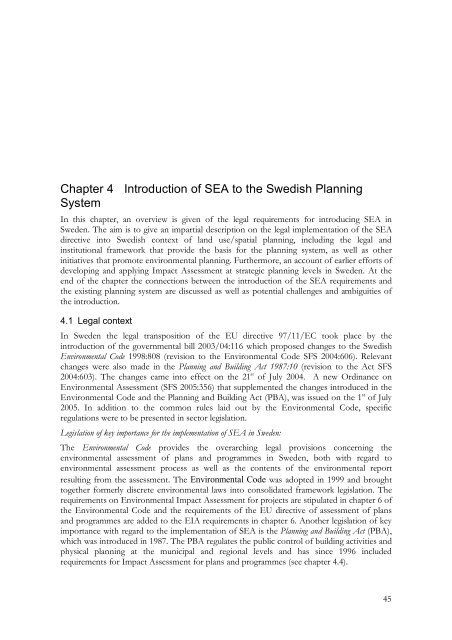SEA IN THE CONTEXT OF LANDTUSE PLANNING
SEA IN THE CONTEXT OF LANDTUSE PLANNING
SEA IN THE CONTEXT OF LANDTUSE PLANNING
You also want an ePaper? Increase the reach of your titles
YUMPU automatically turns print PDFs into web optimized ePapers that Google loves.
Chapter 4 Introduction of <strong>SEA</strong> to the Swedish PlanningSystemIn this chapter, an overview is given of the legal requirements for introducing <strong>SEA</strong> inSweden. The aim is to give an impartial description on the legal implementation of the <strong>SEA</strong>directive into Swedish context of land use/spatial planning, including the legal andinstitutional framework that provide the basis for the planning system, as well as otherinitiatives that promote environmental planning. Furthermore, an account of earlier efforts ofdeveloping and applying Impact Assessment at strategic planning levels in Sweden. At theend of the chapter the connections between the introduction of the <strong>SEA</strong> requirements andthe existing planning system are discussed as well as potential challenges and ambiguities ofthe introduction.4.1 Legal contextIn Sweden the legal transposition of the EU directive 97/11/EC took place by theintroduction of the governmental bill 2003/04:116 which proposed changes to the SwedishEnvironmental Code 1998:808 (revision to the Environmental Code SFS 2004:606). Relevantchanges were also made in the Planning and Building Act 1987:10 (revision to the Act SFS2004:603). The changes came into effect on the 21 st of July 2004. A new Ordinance onEnvironmental Assessment (SFS 2005:356) that supplemented the changes introduced in theEnvironmental Code and the Planning and Building Act (PBA), was issued on the 1 st of July2005. In addition to the common rules laid out by the Environmental Code, specificregulations were to be presented in sector legislation.Legislation of key importance for the implementation of <strong>SEA</strong> in Sweden:The Environmental Code provides the overarching legal provisions concerning theenvironmental assessment of plans and programmes in Sweden, both with regard toenvironmental assessment process as well as the contents of the environmental reportresulting from the assessment. The Environmental Code was adopted in 1999 and broughttogether formerly discrete environmental laws into consolidated framework legislation. Therequirements on Environmental Impact Assessment for projects are stipulated in chapter 6 ofthe Environmental Code and the requirements of the EU directive of assessment of plansand programmes are added to the EIA requirements in chapter 6. Another legislation of keyimportance with regard to the implementation of <strong>SEA</strong> is the Planning and Building Act (PBA),which was introduced in 1987. The PBA regulates the public control of building activities andphysical planning at the municipal and regional levels and has since 1996 includedrequirements for Impact Assessment for plans and programmes (see chapter 4.4).45
















